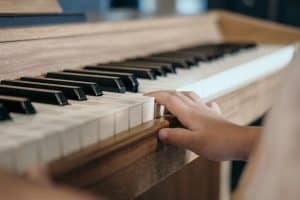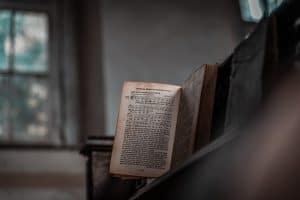Learning how to read sheet music is an invaluable skill. It will make learning songs on the piano much easier and intuitive. If you already play by ear that’s a great skill to have, however learning to read piano sheet music will enhance your musicianship and allow you to communicate and preserve your music with greater ease. Although learning this skill takes some time, knowing how to read piano sheet music will make you a more well rounded musician. It’s well worth the effort!
What is sheet music?
Sheet music is music in written form. It includes directions on rhythm, pitch and harmony. It also includes other directions on tempo, key, style and groove. Composers and songwriters write down their music to preserve it and so other people can play it.
Monks were some of the first to notate their music as a series of little dashes on a few horizontal lines. As music evolved over time notation became standardized into the form we know today. In recent years the music notation process has progressed onto the computer. There are specialized softwares that can produce sheet music. Now reading, writing and sharing sheet music has never been easier!
Why should you learn to read music?
Reading sheet music makes playing and learning the piano more accessible. It doesn’t take long to get started, especially if you do a small amount of regular reading every day.
Here are some great reasons why you should learn to read sheet music:
- Autonomy: Learning how to read music means you can learn to play any song you like without the need of a teacher.
- Confidence: If you learn to read piano music, you’ll feel more confident and learn the music much faster. If you play keyboard in a band, being able to read sheet music will make you more valuable to the group.
- Replace playing by ear and online tutorials: Playing by ear is a great skill to have. However, it’s not always an option and learning from tutorials can be slow and frustrating. Knowing how to read music for piano will make it quicker to learn any song.
Music notation components
Reading piano sheet music is made up of several different components. Sheet music can be broken down into the following elements:
Pitch
Pitch refers to how high or low the note is. Musical notes appear on the five lines of the staff. The higher up the notes appear on the staff, the higher pitch they are on the piano. The lower they are on the staff, the lower pitch they are on the piano.
Rhythm
Rhythmic notation dictates when and how long to play each note for. Some are as long as four beats (a whole note) and others can be as short as one sixteenth of a beat (a sixteenth note) or even shorter.
Articulation and dynamics
Articulation tells you how to play the notes. Notes can be played many different ways, detached or smooth or anywhere in between. Detached notes have a moment of silence between them. Smooth notes are blended with no silence between them. Dynamic markings tell you how loud or soft you should play the notes.
Performance directions
Performance directions give the reader an idea of the feeling and tempo of a piece. Tempo markings, like allegro (fast) or adagio (slow), tell you how quickly to play or can simply tell you the BPM (beats per minute) of the piece against a rhythmic value. Expression markings, such as dolce (sweetly) or energico (energetically), give an idea of character and style. These directions bring the music to life.
In this article we will focus on two of these elements, pitch and time. Let’s start by exploring these elements and terminology before we put it into practice.
The staff
Piano notes and information on how to play them is presented on five horizontal lines known as “the staff”. The staff is divided into “measures” or “bars” created by horizontal “barlines”. Each bar contains a particular number of beats set by the time signature, also on the staff you will find the clef and key signatures.
Clefs
Piano sheet music uses two different clefs. The treble clef usually indicates notes are above middle C. It is usually played by the right hand.
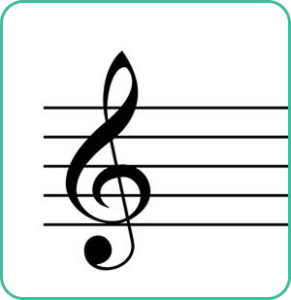
The bass clef mostly depicts lower pitches below middle C, usually played by the left hand.
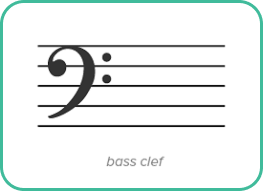
Sometimes the left hand plays notes in the treble and the right hand plays notes in the bass, but that usually only applies in more advanced pieces.
The grand staff
Piano sheet music uses what’s called the grand staff. This combines the treble staff and the bass staff together with a brace to show that it is one line of music:

Key signatures
Next to the clef you can find the key signature. Key signatures inform musicians of any notes that have to be sharpened or flattened throughout a piece or section of music. Rather than putting the sharp or flat symbol in front of every note that needs it, they are placed at the beginning of each line of music.
A key signature can have no sharps or flats, or as many as seven sharps or flats. Key signatures never mix sharps and flats. 
Time signatures
After the clef and the key signature you’ll see two numbers, one on top of the other. This is called a time signature. The top number tells you how many beats there are in each “measure” or “bar” which gives you the pulse of the music.

How to read music notes
Having covered the staff which notes are placed on let’s look at the notes themselves.
Note heads, stems, flags and beams
A music note has multiple indicators of its duration based on the head, stem and flag or beam. The “note head” is the circle that sits on the staff and tells you what the pitch is. They are hollow or filled depending on duration. Note lengths are also dictated by a “stem” or lack thereof, quicker notes have a “flag” or “beam” on the stem. Flags can link together into a beam when in succession for ease of reading.
This is all part of rhythm. Here are the basic note values:

Every note value has a “rest” equivalent. A rest is a symbol that has no pitch or note and is used to denote periods of musical silence.
Pitch : reading the notes on the staff
Now you can make sense of rhythm values and we can move on to reading pitch.
There are two types of music notes on a staff:
- Space notes: These are the notes that sit in between the five lines,
- Line notes: These have a line running through them
Reading the right hand notes
The space notes for the treble clef are:

They are easy to remember, they spell the word F A C E, remember “face in the space”.
The treble line notes are:

These don’t spell a word, but remember a phrase to help you, such as Every Green Bus Drives Fast.
Here is middle C notated for the right hand. Notice that it has a line running through it. This is called a ledger line. Ledger lines are used to notate pitches that go above or below the range of the staff.

Reading the left hand notes
The notes for the left hand look the same. Remember that it’s the bass clef that changes the note names.
Left hand space notes
The left hand space notes are A – C – E – G.
Remember these with the phrase All Cows Eat Grass – or make up your own phrase.

Keep in mind these notes are two are played much lower on the piano as middle C is now located above the staff.

The left hand line notes are G – B – D – F – A.
A good phrase to help remember this is Good Boys Deserve Football Always. Here are the left hand line notes on the staff:

How to read sheet music by interval
The musical term for the distance between two notes is an “interval”. Once you can recognize the notes on the staff in each hand there is a quick way to get from one note to the other. This is called reading by interval.
Scale type melodies
It’s easy to recognize a scale within a song, it’s when the notes go up or down by steps. When you’re learning a new song with piano sheet music, look out for scales. They will look something like this:

Melodies that jump or leap
Sometimes a melody skips a note, or several notes. If the melody goes from a space note to the next space note, you just have to jump over the line note in between them. This is called a “third” in music. You’ll see plenty of them. This works going up as well as going down. Try spotting more of these connections as you get more familiar with reading sheet music
Accidentals
The three common accidentals are sharps, flats and naturals. These symbols can change the notes in a piece or make up a key signature. A sharp raises the pitch of a note and a flat lowers, a natural means play the white key.
See how accidentals are used in a piece:

Accidentals tell you when to alter a note When you examine a labeled piano keyboard you see that the black notes are labeled with both flats and sharps. When a key signature accidentally is used you must alter that note to play the corresponding key on the keyboard. With the example above you would alter the C to be black note to the right, a C#.
There are several rules about accidentals that apply to piano sheet music:
An accidental does not apply to the same note in any other octave.
- The alteration only applies to the exact note it’s in front of for one measure unless canceled by another accidental. It doesn’t apply to the other hand or other octave.
An accidental applies to that note through that measure.
- Accidentals are temporary. If you see an F sharp in a measure and that same exact note comes up again later in the same measure, it remains sharp. If the composer doesn’t want it to be sharp, they will add a natural in front of the second F.
A note with an accidental that’s tied to a note in the next measure stays altered by the accidental from the previous measure.
- If you see a note altered by an accidental that is tied over a barline this means that the note stays altered through the barline.
Understanding key signatures
The sharps (♯) or flats (♭) you sometimes see at the beginning of a staff is called a key signature. These accidentals specify the notes throughout the piece that should be altered regardless of octave. If a key signature has a flat on the B line, every B throughout the piece is played flat unless it is canceled out by another accidental or a change of key signature.

The use of key signatures makes the notation process easier by eliminating the need to repeatedly mark sharps or flats on individual notes.
The key signatures of a piece create the mood and feeling of a piece and lets the musician know what scale they are in. A modulation, the term for a change in key signature, can change the key or tonality of a piece and have a great effect on the way the music you are reading sounds so be careful to pay attention to them when you are reading.
What is the cycle of fifths
The circle or cycle of fifths is a tool musicians use to work out scales and keys. It lays out keys in a way that shows their relationships to one another. The circle of fifths will become an increasingly invaluable tool as you begin to explore key signatures and scales.
How to use the cycle of fifths
Scales and key signatures provide a framework for melodies and harmonies in music. A musical scale is a sequence of notes arranged in ascending or descending order by pitch, following a specific pattern of intervals. Scales and key signatures use sharps and flats to get specific sounds and keep distances between notes consistent whichever note you start from. The key signature makes these patterns playable in any key.
The cycle of fifths layout not only helps in identifying key signatures and scales it helps musicians understand the harmonic relationships between tonal centres. It lays out all of the 12 notes of the musical alphabet cycling round in fifths. The keys with sharps go clockwise and the keys with flats go counter clockwise from C the key with no sharps or flats. Use this helpful diagram and these mnemonics to know how to add the sharps and flats to each key or scale.
Let’s figure out some scales and keys to help you understand this concept.

Sharp keys and scales (clockwise movement)
Each step adds a sharp you will see the “1#” under G at 1 o’clock on the cycle. The mnemonic for the order of sharps is:
Father Charles Goes Down And Ends Battle
Each key has one of every musical letter of the alphabet starting and ending on the root.
To figure out which sharps to add, count how many steps round the cycle that key is and make those changes to create that scale based on the mnemonic Father being the first sharp and Charles being the second etc.
For example:
- A G scale will have a G A B C D E F and a G
- Looking at the cycle, G major has one sharp F# (Father) → G A B C D E F# G
- A A scale will have a A B C D E F G and an A
- A major has three sharps F#, C#, G# (Father Charles Goes) → A B C# D E F# G# A
Each scale and key signature share the same sharps. As you see here just like the scale the G major key signature has one sharp.

Flat keys (counterclockwise movement)
Each step in this direction adds a flat. Use this mnemonic:
Battle Ends And Down Goes Charles Father
As with sharp keys all scales have one of every letter. Let’s use this knowledge to work out a couple of flat keys. For example:
- Bb major has one flat (Bb) → Bb C D Eb F G A Bb
- Eb major has three flats (Bb, Eb, Ab) → Eb F G Ab Bb C D Eb
These patterns work the same way for both treble and bass clefs, making it useful no matter what instrument you play. As before each scale and key signature share the same flats. As you see here just like the scale the Bb major key signature has two sharps.

Understanding minor keys
Minor key signatures are a sadder sounding contrast to the major keys.
The circle of fifths shows both relative majors and minors keys, each minor key has its own relative major and vice versa. Relative major and minor keys share the same key signature but start on different notes, giving the scales different sounds.
For example, A minor is the relative minor of C major and both share no sharps or flats in their key signature.
You can see this relationship on our circle of fifths diagram above. If you don’t have a circle of fifths handy you can always count six notes up or three notes down a major to find the relative minor. Try this out now and use the cycle as a reference to see if you get the right answer. You can also use the Skoove app to help you get used to this new sound.
Understanding time signatures
To understand time signatures you need to understand what both the numbers mean. The bottom number tells you what type of notes the beats are. For instance if the bottom number is 4, the beats are quarter notes, if it’s 8 they’re eighth notes and a 2 means they’re half notes.

If you see 4/4 it means there are four quarter notes in each measure, 6/8 means there are 6 eighth notes in each measure. 2/4 means there are two half notes in each measure. This table shows a few basic time signatures and how the note values correspond to the numbers in the time signatures.

How to read piano music
Now you understand all the basics, we can start putting your newfound reading knowledge into practice by playing on the piano and using some handy Skoove lessons.
Corresponding notes on piano
As we looked at previously the staff shows what pitch to play. Each note on the staff corresponds to a key on the piano. Learning the note placement on the keyboard alongside notation helps reinforce reading and playing skills. Use this helpful diagram to help you familiarize where each note sits on the staff and where it belongs on the keyboard.
As soon as you feel comfortable try applying your knowledge to some real sheet music. Keep everything slow and steady and take your time.
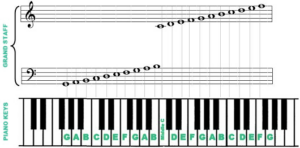
Keeping time
Keeping time and a steady beat are crucial aspects of playing piano and reading sheet music. Using a metronome and working out rhythms before you start to play a piece are great ways to ensure your music keeps time.
Start by counting the beats of a bar keeping a steady pulse then use all that you learned about note values at the start of this article to figure out how everything works together. This can be done by portioning up beats in a bar and dividing them where necessary. To divide beats into eighth notes musicians count ‘1 and 2 and 3 and 4 and’, the ands being the half measure of a beat.

Here are some simple rhythms to get you started. This diagram shows how different note values and rhythms correspond to the beats in a bar of 4/4.

Use Skoove lessons to help you with this so you know you are keeping steady and accurate time. As you get more comfortable with rhythm you can start dividing the bar more and playing more complex rhythms and divisions of a beat.
Playing scales
Scales are a foundational part of learning to read piano music. Practicing scales helps with finger coordination and strengthens note-reading skills. Learning scales is like learning to read words. They are the building blocks of music and will help you recognise patterns and read piano music more fluently.
To play piano scales you can use your knowledge we got from looking at the circle of fifths. Work out your scale and the sharps and flats used to create it as we did using the examples with the cycle of fifths. Then play those keys in sequence following an ascending order and you have a scale!
For instance if we look at F major, we see on the cycle of fifths it has one flat, Bb. We apply this alteration to the musical alphabet from F to F and we have the F major scale:
- F G A Bb C D E F
Be sure to use the correct fingerings to ensure smooth control and good technique.
- F(1) G(2) A(3) Bb(4) -cross over- C(1) D(2) E(3) -cross over- F(1)
If this seems confusing take a look at this helpful lesson once you progress try your hand at some more scales. The more scales you know the easier reading music will become just like increasing your vocabulary!
Sight reading and practice techniques
Sight reading is playing sheet music without having practiced it before. It’s an essential skill for musicians. It can help you learn new pieces faster and make you better at reading music overall. This might seem daunting at first but you sight read written language every day and with practice you will be as comfortable with sheet music.
Top tips to improve your reading
Here are our top tips to get you started with sight reading.
- Practice daily: A few minutes of reading sheet music each day can make a big difference.
- Count the rhythm: Rhythm is just as important as playing the right notes. Try to tap or clap the rhythm of a tricky passage to internalize the timing.
- Recognize patterns: Most music is made up of familiar patterns like the scales we looked at. The more patterns you recognize the easier sight reading is.
- Read ahead: Train yourself to read ahead in the music.
- Play slowly: Accuracy is more important than speed when first learning to read and will help you internalise these concepts.
- Don’t stop: If you make a mistake, keep going. A band won’t stop half way through a song if you mess up. Sight reading isn’t about perfection it’s about keeping the music flowing.
Resources for learning to read piano music
Skoove has a great catalog of easy tunes for you to get to grips with sight reading. Try playing along with Don Mclean’s American Pie. Focus on the simple rhythm and notice how the melody moves in scale like patterns.
Once you’ve got to grips with this there are many more songs to explore. Try it today you can find and sight read one of your favorite songs or even find a new one.
Conclusion
Now that you have learned the basics of how to read piano sheet music, why not try and put your newfound knowledge to the test? Reading just a bit of sheet music everyday will soon have you putting all of these concepts together and you will be reading sheet music that will feel like language. Be careful, take your time and break down these concepts into manageable chunks to ensure learning is fun and smooth. Make sure to check out Skoove’s extensive catalog of lessons, songs and exercises to help you along your piano playing journey. Happy practicing!









